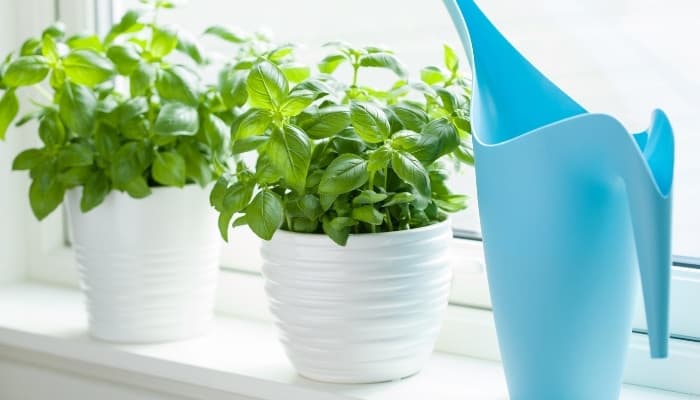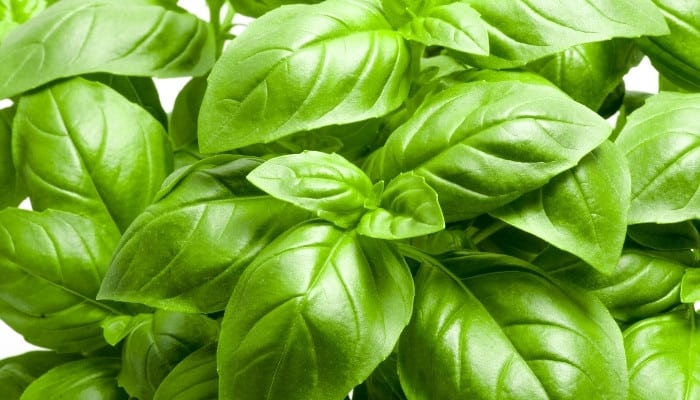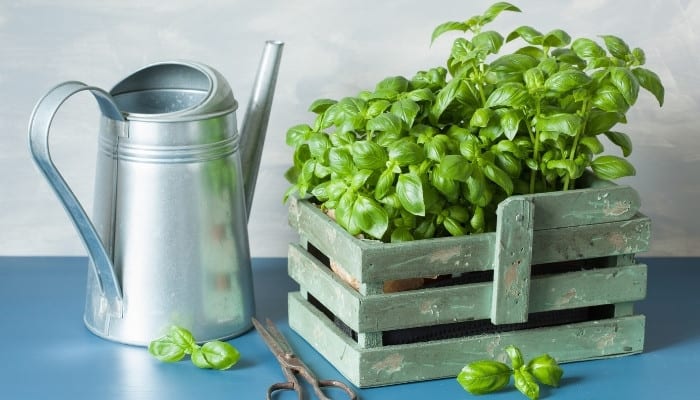Both gardeners and chefs share a fondness for the basil plant due to its fragrant leaves that are essential in numerous Mediterranean cuisines. It is a common element in various sauces and garnishes used globally.
Its soft, peppery flavor and delicate, sweet aroma make it the perfect accompaniment to most tomato-based dishes.
It’s super easy to grow and can easily be grown on the windowsill of a busy kitchen, in the garden, or in containers on the patio.
However, to successfully grow and harvest fresh basil throughout the growing season, the plant requires adequate moisture levels.
How often should you water basil? Many outside factors influence the frequency of watering the basil plant, including sunlight, soil content, plant position, and temperature. Water every 3-5 days to soil moist but not soggy. Increase watering frequency in times of higher temperatures or increased sunlight.
The secret to a healthy basil plant boils down to watering.
By finding that magic balance between, whoa, that’s too much to and eek, that’s too little, you can enjoy the basil plant’s succulent leaves for quite some time.
Read on to discover how to achieve the perfect watering schedule for your basil plant.
Guide To Watering Basil Plants
Without water, all plants, including basil, cannot absorb sufficient nutrients, which results in death.
Although watering may seem like a basic and self-evident requirement, the basil’s penchant for water means this plant is very sensitive to moisture levels or lack thereof.
Basil Water Requirements
Like all plants, basil requires water to grow; the roots absorb water carrying nutrients and minerals from the soil into the plant.
In addition, the basil plant is a soft-structured plant, often described as herbaceous as it has no hardened stem structure to support its leaves and stems.
This means it requires a constant moisture supply to keep its foliage firm and juicy rather than wilted.
Scientifically this is known as turgor pressure, and in plants, this is simply the force exerted by stored water on the plant’s cell walls.
Therefore, basil plants require regular watering to ensure the soil is constantly kept moist and to prevent the foliage from wilting.
How To Check Soil Moisture for Basil Plants
Soil moisture meters are a handy gadget for testing whether the soil is wet, dry, or moist at the root level.
I recommend this meter as it not only provides an accurate reading of moisture levels but also measures pH and light levels.
However, you can also use the old-fashioned gardener’s trick of inserting your finger into the soil to a depth of 1 inch; if the soil is moist, the basil plant does not require watering.
However, if the soil is dry to the touch, it’s time to reach for the watering can or hose and provide a thorough drenching. Ensure the excess water drains well with each soaking.
How Often To Water Basil in the Garden
Basil plants grown in the garden are exposed to the elements, so factors such as season, temperature, rainfall, and sunlight exposure will affect the frequency of your watering schedule.
Even the soil type can have an effect depending on its moisture retention.
However, if the plant is grown in good soil, you will need to water it twice a week if the temperatures are high or once weekly in cooler weather.
Always check the soil around the base of the plant to ensure the soil is moist. You can do this with a trowel; simply dig into the soil and turn the trowel slightly to lift the earth.
You should be able to see if the soil is moist or requires water.
How Often To Water Basil Grown in Outdoor Containers
Growing basil in outdoor containers is easily done, but you should consider the type of container you use pretty carefully.
This is because the outside weather elements and the container type will impact the frequency of your watering regime.
For example, terra cotta pots are perfect for most plants as they absorb moisture and naturally increase humidity levels.
However, they are most suitable for plants that prefer dry soils as they allow both air and water to permeate through them.
This will mean an increased watering schedule to ensure your basil doesn’t dry out.
Large outdoor basil planters will need to be watered every 3-4 days depending on rainfall, while smaller pots may require a daily soaking.
How Often To Water Basil Grown Indoors
Basil plants grown indoors are exposed to warmer temperatures consistently. This is because our homes are naturally warm, especially if the central heating is on.
Also, the soil drys out faster in plant containers. Therefore, water your indoor basil plant at least every 3 days.
However, if the soil is still moist after this period, extend the watering schedule to every 4-5 days.
Using self-watering containers is an excellent idea for indoor basil plants as these will automatically give the roots access to water. However, they will need the water replenished regularly.
This 8-inch self-watering planter is ideal as it is just the right size for basil plants and it self-aerates as well.
How Often To Water Basil Seedlings
Basil seedlings have immature root systems which cannot survive drought-like conditions. Therefore it’s imperative that the soil is kept moist but not soggy.
Water the seedlings once a day or every two days, and ensure the soil is well-draining and retains moisture.
Wondering how long that new basil plant can be expected to live? You can learn all about basil’s life cycle and life expectancy in our article here.
Factors That Influence Basil Watering Frequency

Temperature
Because basil is a herbaceous plant, high temperatures cause the plant to dehydrate and wilt quickly.
Therefore, water at least twice a week for outdoor basil in warmer weather and provide a good soaking in the mornings before a hot day.
Rainfall
Rainy days can decrease the frequency of waterings required; however, rainfall can be light or quickly run off the soil surface.
Therefore, check the soil around your basil plant to ensure it is moist, as you may have to top up on mother nature’s quick sprinkle.
Humidity
The basil plant enjoys humid conditions as it is a tropical plant that originates from Southern Asia.
High humidity levels result in less water being lost by the plant to the air. With less water being lost, the watering frequency will also decrease.
Direct Sunlight
Although the basil plant requires at least 7-8 hours of sunlight per day to thrive, longer periods of hot direct sunlight can cause the plant to wilt and suffer leaf scorch.
In addition, direct sunlight will increase the watering requirements needed to prevent the basil from dehydrating. Instead, move the plant into the shade during the hotter hours of the day.
Partial Shade
The sun-loving basil plant also enjoys the shade. Like all herbaceous plants, it needs some relief from direct sunlight to prevent dehydration and leaf scorch.
In addition, a position in the partial shade will mean the soil is protected from drying out, resulting in less moisture loss and less watering.
Soil
The basil plant enjoys moist soil that is not boggy or compacted.
Poor soil with low moisture retention will result in overly dry growing conditions, increasing the need for additional watering sessions.
Conversely, if the soil is too wet and poorly drained, there may be less need for water, but it will cause root rot resulting in the demise of the basil plant.
To improve your soil’s moisture retention, try adding multi-purpose compost to the ground before planting your basil plants. For clay soil, add gypsum or limestone to improve drainage.
What a Healthy Basil Plant Should Look Like

If you are wondering if your basil plant is healthy, then here are a few pointers to consider when checking your basil plant over.
Healthy basil plants should be bright green with healthy, firm, juicy stems and pointy, oblong leaves.
They should not droop or look wilted, and the foliage should be bushy and springy to the touch.
Identifying and Correcting Overwatered Basil
Overwatering basil plants is what happens when plant parents worry about underwatering! We tend to give a little extra water thinking this will be okay when it can actually be detrimental.
Not to worry, if caught early, this problem is easily remedied with a few easy steps.
So, how much is too much water? And how will you know when your basil plant is suffering from the effects of the heavy-handed watering can?
How To Tell If Basil Is Overwatered
The sensitive basil plant will quickly display pale, yellow, and wilted leaves. If you check the roots, you may notice that they have become brown and mushy.
The soil may also be soggy, and the plant looks sickly. This happens with constant overwatering as the plant stands in water for extended periods.
Note that yellow leaves can also be a symptom of other serious issues. We help you troubleshoot in this article.
Problems Associated With Overwatering Basil
The problem with overwatering your basil is that it causes the plant’s health to deteriorate, making it more susceptible to disease.
One common disease associated with overwatering is root rot. This causes the plant to wilt, stunts growth, and impedes the uptake of necessary nutrients and minerals, resulting in an untimely death.
Once root rot sets in, you may have to throw your precious basil plant away, depending on the severity.
Another common disease spread by excessive watering is downy mildew which prefers wet soil and high humidity.
How To Fix Overwatered Basil
Firstly, stop watering your basil! Hold off watering the plant for a few days to give it a chance to recover.
Secondly, check the root system by gently removing the container. If the roots look mushy, try repotting the basil in fresh good-draining soil and hold off watering for few days.
Thirdly, for basil growing in the garden, use a rake and pull away any compost or mulch from around the basil to allow the soil to dry out.
Fourth, remove the yellowing leaves to prevent the plant from wasting energy feeding them and to encourage root health.
If there is no improvement, your basil plant may have gone to plant heaven and sadly cannot be restored to its former glory.
Did you know that while overwatering is a common mistake with basil, these plants do extremely well when grown hydroponically? Learn how easy it is to do here.
Identifying and Correcting Underwatered Basil
Underwatering is a part of gardening life; sometimes life gets hectic, and your plants, including your basil, may suffer a little.
However, by following a few simple steps, this problem can be resolved relatively quickly. So, haul out the hose or watering can; you have some watering to do!
How To Tell If Basil Is Underwatered
Your underwatered basil plant will quickly display wilted leaves that droop and appear sickly.
In addition, the leaves will look yellowish and seem to shrink or shrivel, and the soil will be dry to the touch.
Problems Associated With Underwatering Basil
Thankfully underwatering is much easier to resolve than overwatering.
However, the plant does experience high levels of stress when underwatered, resulting in it being more susceptible to diseases and pests and less productive overall.
How To Fix Underwatered Basil
Check the soil and container to ensure the basil has not become rootbound, as this can also result in reduced moisture retention.
Garden-growing basil will benefit from a mulch or compost added to the soil to help retain moisture.
Provide your underwatered basil with a thorough soaking, and your basil plant should recover quite quickly.
You can also stand smaller containers in trays filled with water to allow for bottom watering but only to help revive the plant if underwatered.
Related Questions:
Does Basil Need Full Sun?
The basil plant is a sun-loving tropical plant that enjoys warm, humid conditions. It thrives in direct sun and should receive at least 7-8 hours of sun each day to keep its leave green and tasty.
However, it is also a soft, herbaceous plant and so will require partial shade during the heat of the summer to prevent wilting and leaf scorch.
If your garden has no shade, use a shade cloth extended between two poles to keep the heat off your basil on hot days.
In addition, seedlings need to be protected from overexposure to the sun to prevent discoloration and wilting.
While the plants are still maturing, place them in a sunny window to acclimatize before planting outdoors.
Why Are My Basil Leaves Curling Up?
Curling leaves on basil are often an indication of pests, disease, or nutrient problems.
Aphids and whiteflies are sucking pests that pierce the leaves to extract the juices. As the leaves grow, the damaged leaf cells cause the plant leaves to curl.
Fungal diseases, such as botrytis mold and downey mildew, can also cause leaf curl in basil plants.
Removal of infected plants is the best solution. In addition, over-fertilizing can cause foliage to curl, mainly if concentrated solutions are applied when the plant has been underwatered.
Conclusion
When growing the basil plant, the simple watering rule is to water frequently while being mindful of soil moisture. It really is that simple.
Not only is this delicious herb easy to grow and care for, but the health benefits it can provide are quite extensive, which is good news for gardeners around the world looking to improve their health.
When next you pick a succulent basil leaf to garnish your salad or pop into your favorite spaghetti sauce, keep in mind that this lovely leafy herb is thought to help prevent cancer.
In addition, it is often credited with the ability to provide pain relieve, reduce inflammation, and help to lower your blood sugar levels. Happy watering to all our basil plant parents!

